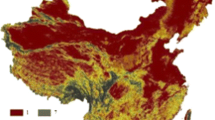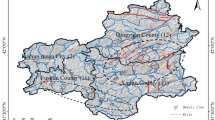Abstract
Debris flow sites were identified at 140 locations in the Xiaojiang Basin in Yunnan province, southwestern China. Their spatial distribution and catchment characteristics are described in detail on the basis of previous research, air photo interpretation, field investigation and mapping using Geographical Information Systems (GIS). Using a statistical approach, a quantitative model of hazards assessment and zonation was developed through synthesis analysis of basin areas, gradients, and the relative reliefs of these debris flow sites. In terms of debris flow hazard assessment, areas within the Xiaojiang Basin can be classified as severe, heavy and light hazard regions.






Similar content being viewed by others
References
Aleotti P, Baldelli P, Polloni G (1996a) Landsliding and flooding events triggered by heavy rain in the Tanaro Basin (Italy). In: Proc International Congress INTERPRAEVENT, 24–28 June 1996, Garmisch Partenkirchen, vol 1. INTERPRAEVENT, Klagenfurt, pp 435–446
Aleotti P, Baldelli P, De Marchi D (1996b) Le reti neurali nella valutazione della pericolosità da frana. Geol Tec Ambient 4:37–48
Aleotti P, Baldelli P, Polloni G, Puma F (1998) Different approaches to landslide hazard assessment, keynote paper. In: Sivakumar M, Chowdhury RN (eds) Proc 2nd Int Conf on Environmental Management (ICEM2), 10–13 February 1998, Wollongong, Australia, vol 1. Elsevier, Oxford, pp 3–10
Anbalagan R, Singh B (1996) Landslide hazard and risk assessment mapping of mountainous terrains—a case study from Kumaun Himalaya, India. Eng Geol 43:237–246
Baldelli P, Aleotti P, Polloni G (1996) Landsliding susceptibility numerical map at the Messina Strait crossing site. In: Senneset K (ed) Proc 7th Int Symposium on Landslides, 17–21 June 1996, Trondheim, vol 1. Balkemia, Rotterdam, pp 153–158
Benda L (1990) The influence of debris flows on channels and valley floors in the Oregon coast range, U.S.A. Earth Surf Proc Landforms 15:457–466
Bogucki DJ (1976) Debris slides in the Mt. Le Conte Area, Great Smoky Mountains National Park, U.S.A. Geogr Ann 58:179–191
Bughi S, Aleotti P, Bruschi R, Andrei G, Milani G, Sakellariadi E, Scarpelli G (1996) Slow movements of slopes interfering with pipelines: modeling vs monitoring. In: Chakrabarti S (ed) Proceedings of the 15th International Conference on Offshore Mechanics and Arctic Engineering, Florence, Italy, June 1996. ASME, Fairfield, 1020 pp
Campbell RH (1975) Soil slips, debris flows, and rainstorms in the Santa Monica Mountains and vicinity, southern California. US Geological Survey Professional Paper 851, 51 pp
Cenderelli DA, Kite JS (1998) Geomorphic effects of large debris flows on channel morphology at North Form Mountain, West Virginia, U.S.A. Earth Surf Proc Landorms 23:1-99
Chowdhury RN (1998) Evolving geotechnical reliability assessment strategies. In: Year 2000 Geotechnics. Asian Institute of Technology, Bangkok
Costa JE (1984) Physical geomorphology of debris flows. In: Costa JE, Fleischer PJ (eds) Developments and applications in geomorphology. Springer, Berlin Heidelberg New York, pp 268–317
Cui P (1999) Impact of debris flow on the river channel in the upper reaches of the Yangtze River. Int J Sediment Res 14(2):201–203
Cui P, Wei FQ, Li Y (1999) Sediment transported by debris flow to the Lower Jinsha River. Int J Sediment Res 14(4):67-71
Davies TRH (1997) Using hydroscience and hydrotechnical engineering to reduce debris flow hazards. In: Chen C (ed) Debris-flow hazards mitigation: mechanics, prediction, and assessment. American Society of Civil Engineers, Reston, pp 787–810
Du RH, Kang ZC, Chen XQ, Zu PY (1987) Comprehensive investigation and control planning for debris flows in Xiaojiang River Basin of Yunnan Province (in Chinese). Sichuan Sci and Tech Press, Chongqing Branch, pp 33
Fell R (1994) Landslide risk assessment and acceptable risk. Can Geotech J 31(2):261–272
Gupta P, Anbalagan R (1997) Slope stability of Tehri Dam reservoir area, India, using landslide hazard zonation (LHZ) mapping. Q J Eng Geol 30:27–36
Hack JT, Goodlett JC (1960) Geomorphology and forest ecology of a mountain region in the central Appalachians. US Geological Survey Professional Paper 347, 66 pp
Harris HJ, Wenger RB, Harris VA, Devault DS (1994) A method for assessing environmental risk: a case study of Green Bay, Lake Michigan, USA. Environ Manage 18(2):295–306
Jan CD, Shen HW (1997) Review of dynamic modeling of debris flows. In: Armanini A, Michiue M (eds) Recent developments on debris flows. Springer, Berlin Heidelberg New York, pp 93–116
Kappos AJ, Stylianidis KC, Pitilakis K (1998) Development of seismic risk scenarios based on a hybrid method of vulnerability assessment. Nat Hazards 17(2):177–192
Keefer DK, Wilson RC, Mark RK, Brabb EE, Brown III WM, Ellen SD, Harp EL, Wieczorek GF, Alger CS, Zatkin RS (1987) Real-time landslide warning during heavy rainfall. Science 238:921–925
Klein RJT, Nicholls RJ (1999) Assessment of coastal vulnerability to climate change. Ambio 28(2):182–187
Lees BG (1996) Neural networks applications in the geosciences: an introduction. Comput Geosci 22:955–957
Leroi E (1996) Landslide hazard-risk maps at different scales: objectives, tools and developments. In: Senneset R (ed) Landslides. Balkema, Rotterdam, pp 35–51
Liam Finn WD (1993) Geotechnical aspects of the estimation and mitigation of earthquake risk. In: Tucker BE, Erdik M, Hwang CN (eds) Issues in urban earthquake risk. Kluwer, Dordrecht, pp 35–77
Liu XL (1996) Morphologic characteristics of debris flow fans in Xiaojiang Valley in southwestern China. Z Geomorphol 106:239–254
Liu XL, Yue ZQ, Tham LG, Lee CF (2002) Empirical assessment of debris flow risk on a regional scale in Yunnan Province, southwestern China. Environ Manage 30(2):249–264
Panizza M (1975) Ricerche di geomorfologia applicata alla pian-ificazione territoriale. Mem Soc Geol It 14:109–112
Pierson TC (1980) Erosion and deposition by debris flows at Mount Thomas, North Canterbury, New Zealand. Earth Surf Proc 5:227–247
Pierson TC (1986) Flow behavior in channelized debris flows, Mount St. Helens, Washington. In: Abrahams AD (ed) Hillslope processes. Allen and Unwin, Boston, pp 269–196
Scott KM (1971) Origin and sedimentology of 1969 debris flows near Glendora, California. U.S. Geological Survey Professional Paper 750-C, pp 242-247
Smith K (1996) Environmental Hazards: Assessing Risk and Reducing Disaster. Routledge, London, 389 pp
Walsh SJ, Butler DR, Malanson GP (1998) An overview of scale, pattern, process relationships in geomorphology: a remote sensing and GIS perspective. Geomorphology 21:183–205
Wang ZY, Wai WH, Cui P (1999) Field investigation into debris flow mechanism. Int J Sediment Res 14(4):10–22
Wei FQ, Xie H, Zhong DL (1998) Methods for zoning dangerousness of debris flow in the area with complete information. In: Catalogue, database, regional rules of debris flows and landslides (in Chinese). Sichuan Sci. & Tech. Press, Chengdu, pp 31–36
Wei FQ, Hu KH, Cui P, Zhong DL, Xie H, He YP (2002) Decision support system of debris flow mitigation for mountain towns (in Chinese). J Nat Disasters 11(2):31–36
Williams GP, Guy HP (1973) Erosional and depositional aspects of Hurricane Camille in Virginia, 1969. US Geological Survey Professional Paper 804, 80 pp
Xie H, Zhong DL, Wei FQ, Lin LH (1998) Danger degree regionalization in major regions of debris flow and landslide catalogue. In: Catalogue, database, regional rules of debris flows and landslides (in Chinese). Sichuan Sci & Tech Press, Chengdu, pp 37–41
Yang G (1992) Culture relics book, book 3 (in Chinese). Yunnan Culture Relic Press,Yunnan
Zhang S (1990) Evaluation and updating of slope reliability. PhD Thesis, University of Wollongong, Australia
Acknowledgements
We thank Liu Hong-Jiang, Chen Xiao-Qing, Hu Kai-Heng, and Yang Zhao-Lin for their field co-investigation and Prof. Tang Chuan, Li Yong and an anonymous reviewer for constructive suggestions. This study was funded by the special support project of Chinese Academy of Sciences for mountain hazards: debris flow and landslide, National Science Fund for Distinguished Young Scholars (40025103), and Special Support project of CAS for graduate student: the practice of science and society—innovation type.
Author information
Authors and Affiliations
Corresponding author
Rights and permissions
About this article
Cite this article
He, Y.P., Xie, H., Cui, P. et al. GIS-based hazard mapping and zonation of debris flows in Xiaojiang Basin, southwestern China. Env Geol 45, 286–293 (2003). https://doi.org/10.1007/s00254-003-0884-0
Received:
Accepted:
Published:
Issue Date:
DOI: https://doi.org/10.1007/s00254-003-0884-0




